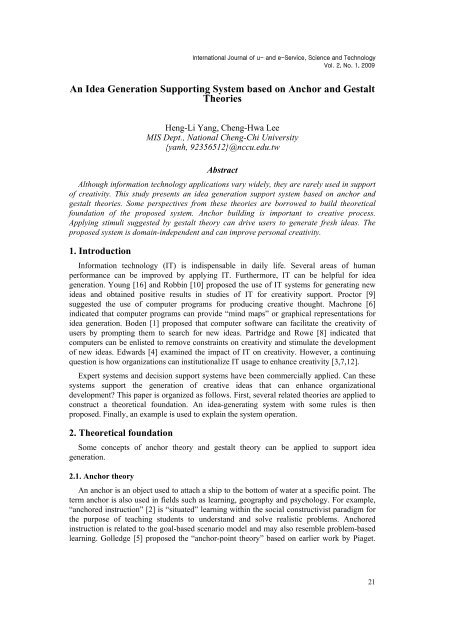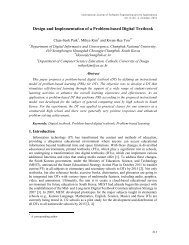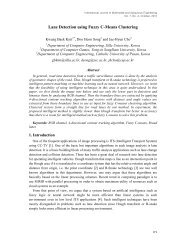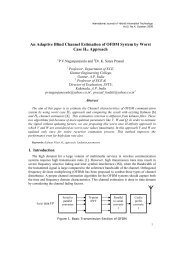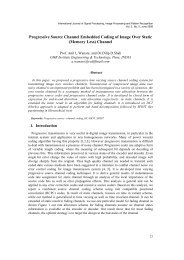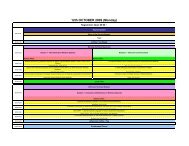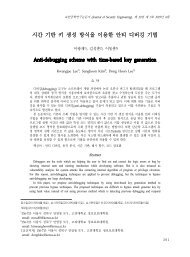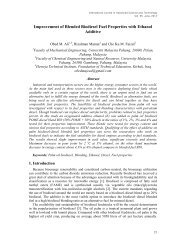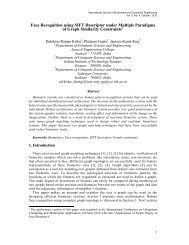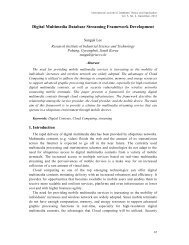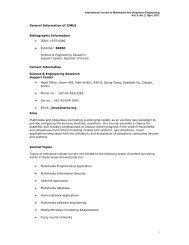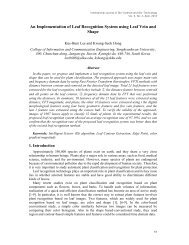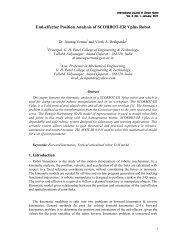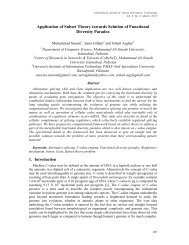An Idea Generation Supporting System based on Anchor ... - SERSC
An Idea Generation Supporting System based on Anchor ... - SERSC
An Idea Generation Supporting System based on Anchor ... - SERSC
Create successful ePaper yourself
Turn your PDF publications into a flip-book with our unique Google optimized e-Paper software.
Internati<strong>on</strong>al Journal of u- and e-Service, Science and Technology<br />
Vol. , No. , 2009<br />
<str<strong>on</strong>g>An</str<strong>on</strong>g> <str<strong>on</strong>g>Idea</str<strong>on</strong>g> <str<strong>on</strong>g>Generati<strong>on</strong></str<strong>on</strong>g> <str<strong>on</strong>g>Supporting</str<strong>on</strong>g> <str<strong>on</strong>g>System</str<strong>on</strong>g> <str<strong>on</strong>g>based</str<strong>on</strong>g> <strong>on</strong> <str<strong>on</strong>g>An</str<strong>on</strong>g>chor and Gestalt<br />
Theories<br />
Heng-Li Yang, Cheng-Hwa Lee<br />
MIS Dept., Nati<strong>on</strong>al Cheng-Chi University<br />
{yanh, 92356512}@nccu.edu.tw<br />
Abstract<br />
Although informati<strong>on</strong> technology applicati<strong>on</strong>s vary widely, they are rarely used in support<br />
of creativity. This study presents an idea generati<strong>on</strong> support system <str<strong>on</strong>g>based</str<strong>on</strong>g> <strong>on</strong> anchor and<br />
gestalt theories. Some perspectives from these theories are borrowed to build theoretical<br />
foundati<strong>on</strong> of the proposed system. <str<strong>on</strong>g>An</str<strong>on</strong>g>chor building is important to creative process.<br />
Applying stimuli suggested by gestalt theory can drive users to generate fresh ideas. The<br />
proposed system is domain-independent and can improve pers<strong>on</strong>al creativity.<br />
1. Introducti<strong>on</strong><br />
Informati<strong>on</strong> technology (IT) is indispensable in daily life. Several areas of human<br />
performance can be improved by applying IT. Furthermore, IT can be helpful for idea<br />
generati<strong>on</strong>. Young [16] and Robbin [10] proposed the use of IT systems for generating new<br />
ideas and obtained positive results in studies of IT for creativity support. Proctor [9]<br />
suggested the use of computer programs for producing creative thought. Machr<strong>on</strong>e [6]<br />
indicated that computer programs can provide “mind maps” or graphical representati<strong>on</strong>s for<br />
idea generati<strong>on</strong>. Boden [1] proposed that computer software can facilitate the creativity of<br />
users by prompting them to search for new ideas. Partridge and Rowe [8] indicated that<br />
computers can be enlisted to remove c<strong>on</strong>straints <strong>on</strong> creativity and stimulate the development<br />
of new ideas. Edwards [4] examined the impact of IT <strong>on</strong> creativity. However, a c<strong>on</strong>tinuing<br />
questi<strong>on</strong> is how organizati<strong>on</strong>s can instituti<strong>on</strong>alize IT usage to enhance creativity [3,7,12].<br />
Expert systems and decisi<strong>on</strong> support systems have been commercially applied. Can these<br />
systems support the generati<strong>on</strong> of creative ideas that can enhance organizati<strong>on</strong>al<br />
development? This paper is organized as follows. First, several related theories are applied to<br />
c<strong>on</strong>struct a theoretical foundati<strong>on</strong>. <str<strong>on</strong>g>An</str<strong>on</strong>g> idea-generating system with some rules is then<br />
proposed. Finally, an example is used to explain the system operati<strong>on</strong>.<br />
2. Theoretical foundati<strong>on</strong><br />
Some c<strong>on</strong>cepts of anchor theory and gestalt theory can be applied to support idea<br />
generati<strong>on</strong>.<br />
2.1. <str<strong>on</strong>g>An</str<strong>on</strong>g>chor theory<br />
<str<strong>on</strong>g>An</str<strong>on</strong>g> anchor is an object used to attach a ship to the bottom of water at a specific point. The<br />
term anchor is also used in fields such as learning, geography and psychology. For example,<br />
“anchored instructi<strong>on</strong>” [2] is “situated” learning within the social c<strong>on</strong>structivist paradigm for<br />
the purpose of teaching students to understand and solve realistic problems. <str<strong>on</strong>g>An</str<strong>on</strong>g>chored<br />
instructi<strong>on</strong> is related to the goal-<str<strong>on</strong>g>based</str<strong>on</strong>g> scenario model and may also resemble problem-<str<strong>on</strong>g>based</str<strong>on</strong>g><br />
learning. Golledge [5] proposed the “anchor-point theory” <str<strong>on</strong>g>based</str<strong>on</strong>g> <strong>on</strong> earlier work by Piaget.<br />
21
Internati<strong>on</strong>al Journal of u- and e-Service, Science and Technology<br />
Vol. , No. , 2009<br />
Golledge suggested that landmarks can help users overcome egocentric perspectives. Some<br />
landmarks are assumed to be required to anchor. The anchor in spatial learning is a critical<br />
role for assisting users in building ground for further links.<br />
Similarly, this study applies the c<strong>on</strong>cept of anchor points to aid idea generati<strong>on</strong> during the<br />
creative process. The anchors of the proposed system are represented by keywords. In an<br />
early stage, an initial anchor would be given to a user to establish a starting point and focus<br />
the inquiry. Human-machine interacti<strong>on</strong>s can then extend user ideas around the anchor.<br />
Additi<strong>on</strong>ally, the system can provide additi<strong>on</strong>al anchors at the appropriate time.<br />
2.2. Gestalt theory<br />
Gestalt psychology is a theory of mind and brain, proposes that the operati<strong>on</strong>al principle of<br />
the brain is holistic, parallel and analog with self-organizing tendencies. It emphasizes higherorder<br />
cognitive processes in the midst of behaviorism [14]. Gestalt theory applies to all<br />
aspects of human learning, although it applies most directly to percepti<strong>on</strong> and problemsolving.<br />
Wertheimer [15] proposed two modes of human thinking: productive and<br />
reproductive. Productive thinking solves a problems through insight; reproductive thinking<br />
solves problems by referring to previous experience and what is already known.<br />
This study applies some rules of idea-generati<strong>on</strong> techniques which facilitate productive or<br />
reproductive thinking of gestalt theory. These rules can initialize something new and break<br />
old rules.<br />
2.3. <str<strong>on</strong>g>Idea</str<strong>on</strong>g>-generati<strong>on</strong> approaches<br />
<str<strong>on</strong>g>Idea</str<strong>on</strong>g>-generati<strong>on</strong> approaches can prompt certain cognitive activities in users. Such<br />
techniques reflect beliefs derived from pers<strong>on</strong>al experience, popular assumpti<strong>on</strong>s, or scientific<br />
research. These techniques can mentally discharge, stimulate people to resp<strong>on</strong>d, or foster idea<br />
generati<strong>on</strong>. VanGundy [13] discussed 105 techniques for structured problem solving. Smith<br />
[11] later reported the analytical results of 172 idea-generati<strong>on</strong> methods, which were<br />
classified into fifteen categories, such as analytical, search, imaginati<strong>on</strong>-<str<strong>on</strong>g>based</str<strong>on</strong>g> and habitbreaking<br />
strategies.<br />
This work presents a “Challenge” rule to stimulate users with habit-breaking strategies via<br />
the following three approaches: perspective change, assumpti<strong>on</strong>s challenge and negati<strong>on</strong>.<br />
Perspective change encourages users to c<strong>on</strong>sider problems from different agent perspectives.<br />
<str<strong>on</strong>g>An</str<strong>on</strong>g> assumpti<strong>on</strong>s challenge drives users to questi<strong>on</strong> beliefs associated with a problem.<br />
Negati<strong>on</strong> applies counter-assumpti<strong>on</strong>s to problem-relevant beliefs. <str<strong>on</strong>g>An</str<strong>on</strong>g>other rule proposed in<br />
this work is “Jump”, including the “fantasy” technique, which is an imaginati<strong>on</strong>-<str<strong>on</strong>g>based</str<strong>on</strong>g><br />
strategy for encouraging users to c<strong>on</strong>ceive of states in which the c<strong>on</strong>straints of reality do not<br />
apply. These two rules are applied to implement the c<strong>on</strong>cept of gestalt theory.<br />
Besides “Challenge” and “Jump”, this study also implements a “<str<strong>on</strong>g>System</str<strong>on</strong>g>atizati<strong>on</strong>” rule<br />
<str<strong>on</strong>g>based</str<strong>on</strong>g> <strong>on</strong> analytical and search strategies. This rule includes several techniques:<br />
decompositi<strong>on</strong>, translati<strong>on</strong>, associati<strong>on</strong>, and analogy. Decompositi<strong>on</strong> reduces wholes into<br />
parts and attributes. Translati<strong>on</strong> c<strong>on</strong>verts <strong>on</strong>e kind of thing into another. Associati<strong>on</strong> follows<br />
associative links am<strong>on</strong>g ideas <str<strong>on</strong>g>based</str<strong>on</strong>g> <strong>on</strong> a knowledge base. <str<strong>on</strong>g>An</str<strong>on</strong>g>alogy is the strategy of solving<br />
problems by identifying and comparing similar problems and soluti<strong>on</strong>s.<br />
3. <str<strong>on</strong>g>System</str<strong>on</strong>g> Architecture<br />
22
Internati<strong>on</strong>al Journal of u- and e-Service, Science and Technology<br />
Vol. , No. , 2009<br />
Fig. 1 shows the proposed system architecture for idea generati<strong>on</strong>, which is divided into<br />
two layers: the database layer and the system layer. According to the stimulus-resp<strong>on</strong>se model<br />
of behaviorism, a stimulus encourages resp<strong>on</strong>se. Therefore, in proposed architecture, some<br />
stimuli are given through human-machine interacti<strong>on</strong>s to encourage subjects to expand their<br />
thinking.<br />
The following scenario illustrates the functi<strong>on</strong> of the proposed system. Assume the<br />
problem is website development. The following issues must be addressed: the type of website;<br />
the services provided; the necessary techniques and tools; the revenue model; the service fee.<br />
The proposed system would provide stimuli to assist users in solving the problem.<br />
administrator<br />
user<br />
<str<strong>on</strong>g>System</str<strong>on</strong>g> layer<br />
management<br />
Stimulus-generating<br />
PT<br />
ODB<br />
RB<br />
Mind-map<br />
Data layer<br />
Figure 1. Proposed system architecture<br />
3.1 Database Layer<br />
The database layer includes an <strong>on</strong>tological base for storing domain knowledge (ODB), a<br />
rule base (RB) with pre-defined rules for providing stimuli, a problem template (PT) for<br />
storing the models related to specific problems, and mind-map data c<strong>on</strong>sisting of user’s mind<br />
maps and thinking tracks while generating ideas. The ODB and PT are independent of the<br />
specific domain. Users can switch between domains as necessary.<br />
adopt<br />
tool<br />
use<br />
technique<br />
role<br />
need<br />
services<br />
has<br />
lead<br />
Revenue<br />
model<br />
by<br />
channel<br />
feature<br />
Figure 2. PT<br />
The ODB and PT are essential and necessary to support user idea generati<strong>on</strong>. The <strong>on</strong>tology<br />
structure of the ODB includes three elements: c<strong>on</strong>cepts, attributes and relati<strong>on</strong>s. The relati<strong>on</strong>s<br />
between c<strong>on</strong>cepts can be classified as independent, intersecti<strong>on</strong> and inheritance. This example<br />
includes role <strong>on</strong>tology, service <strong>on</strong>tology, revenue <strong>on</strong>tology and channel <strong>on</strong>tology. The PT<br />
stores models related to specific problems. The entity-relati<strong>on</strong>ship diagram can be used as a<br />
template for describing the platform of interest. In this scenario, the main c<strong>on</strong>siderati<strong>on</strong>s are<br />
23
Internati<strong>on</strong>al Journal of u- and e-Service, Science and Technology<br />
Vol. , No. , 2009<br />
who (what role) needs services, what services are provided, what tools or techniques are<br />
adopted, what revenue is available and what channel is used (Fig. 2).<br />
A mind map is a diagram of words, ideas, tasks, or other items linked to and arranged<br />
around a central key-word or idea. A mind map can be used to generate, visualize, structure<br />
and classify ideas and can provide an aid for studying, organizing, problem solving, decisi<strong>on</strong><br />
making and writing.<br />
The RB stores pre-defined rules for giving stimuli. The rules are “Challenge”, “Jump” and<br />
“<str<strong>on</strong>g>System</str<strong>on</strong>g>atizati<strong>on</strong>”. To implement these rules, this study adopts several idea-generati<strong>on</strong><br />
techniques such as assumpti<strong>on</strong>s challenge, negati<strong>on</strong>, perspective change, fantasy,<br />
decompositi<strong>on</strong>, translati<strong>on</strong>, associati<strong>on</strong> and analogy. These techniques are used to provide the<br />
user with appropriate stimuli related to the problem. The available rules and approaches are<br />
illustrated here.<br />
Three approaches assumpti<strong>on</strong>s challenge, negati<strong>on</strong> and perspective change are<br />
implemented for the rule “Challenge”. Assumpti<strong>on</strong>s challenge questi<strong>on</strong>s the beliefs of users.<br />
For example, users would generally c<strong>on</strong>sider service fees when planning web operati<strong>on</strong>s.<br />
However, the system might ask whether services could be offered free to users. Negati<strong>on</strong><br />
provides the opposite idea to users. For example, the system might ask a user focusing <strong>on</strong><br />
male web visitors whether female visitors should be c<strong>on</strong>sidered. Perspective change is the<br />
modifying of background of problems. For example, regarding a service (e.g., GPS tool)<br />
originally provided for mobile users, the system might ask whether it could be made available<br />
to stati<strong>on</strong>ary users.<br />
Fantasy is a “Jump” rule. In some cases, imaginati<strong>on</strong> is very useful. This technique<br />
provides some unthinkable stimuli. For example, web users are usually assumedly as human,<br />
but the system might ask if users could be animals. <str<strong>on</strong>g>An</str<strong>on</strong>g>other example might be to c<strong>on</strong>sider<br />
paying users to request services since most websites charge.<br />
Four techniques decompositi<strong>on</strong>, translati<strong>on</strong>, associati<strong>on</strong> and analogy are implemented for<br />
the rule “<str<strong>on</strong>g>System</str<strong>on</strong>g>atizati<strong>on</strong>”. Decompositi<strong>on</strong> reduces wholes into parts and attributes. When<br />
c<strong>on</strong>sidering the roles of web users, the system requests users to describe the attributes of their<br />
roles, such as gender, age, identity, etc. Translati<strong>on</strong> c<strong>on</strong>verts <strong>on</strong>e thing into another. For<br />
example, cash might be c<strong>on</strong>verted to credit charge. The system might suggest VISA instead<br />
of cash. <str<strong>on</strong>g>An</str<strong>on</strong>g>alogy is the search for <strong>on</strong>es similar to parts of the problem situati<strong>on</strong>.<br />
3.2 <str<strong>on</strong>g>System</str<strong>on</strong>g> Layer<br />
The system layer includes two modules. The first is the management module, which<br />
includes ODB management, PT management and RB management. The OBD stores domain<br />
knowledge with <strong>on</strong>tology. Thus ODB management allows read, insert, delete and update<br />
domain knowledge. Some models with specific problems are stored in PT. The PT<br />
management also provides a channel for maintaining problem templates. If new rules must be<br />
implemented by idea-generati<strong>on</strong> techniques, RB could be modified by RB management. The<br />
sec<strong>on</strong>d module, stimulus-generating module, is the core module for generating stimuli to<br />
assist users in thinking about a specific problem. This module has two parts: stimulusgenerati<strong>on</strong><br />
and mind-map access. Stimulus-generati<strong>on</strong> is resp<strong>on</strong>sible for giving users<br />
appropriate stimuli according to RB. The functi<strong>on</strong>s of mind-map access are modifying and<br />
tracking user’ mind maps.<br />
24
Internati<strong>on</strong>al Journal of u- and e-Service, Science and Technology<br />
Vol. , No. , 2009<br />
Fig. 3 shows the SGA (Stimulus Given Algorithm) in stimulus-generati<strong>on</strong>.<br />
{Step 1: <str<strong>on</strong>g>System</str<strong>on</strong>g> initializes a questi<strong>on</strong> from PT to user.<br />
Step 2: User chooses <strong>on</strong>e or some answers through interface.<br />
Step 3: <str<strong>on</strong>g>System</str<strong>on</strong>g> generates questi<strong>on</strong>s <str<strong>on</strong>g>based</str<strong>on</strong>g> <strong>on</strong> RB, ODB and user’s choices to user.<br />
Step 4: Build user’s mind map.<br />
Step 5: Repeat Step 3 to Step 4 until model c<strong>on</strong>strains are satisfied.<br />
Step 6: End }<br />
Figure 3. SGA Algorithm<br />
The procedure for the above is as follows. According to anchor theory, the system chooses<br />
a starting point as an anchor. For example, the first questi<strong>on</strong> could be derived from the “role”<br />
in PT. By doing so, it could be selected as an anchor point to start the idea generati<strong>on</strong> process.<br />
The anchor point could be chosen differently. The system provides multiple functi<strong>on</strong>s for<br />
selecting initial points, such as pre-defined or random settings. The stimulus generati<strong>on</strong><br />
module attempts to stimulate the user according to his (her) former answers, ODB, and RB.<br />
The stimuli (questi<strong>on</strong>s) are produced by the Challenge, Jump, or <str<strong>on</strong>g>System</str<strong>on</strong>g>atizati<strong>on</strong> rules in RB.<br />
During the user interacti<strong>on</strong> process, the system adopts a three-stage selecti<strong>on</strong> strategy for<br />
providing stimuli. At the early phase of idea-generati<strong>on</strong>, the most important task is building<br />
an anchor. The major porti<strong>on</strong> of stimuli is <str<strong>on</strong>g>System</str<strong>on</strong>g>atizati<strong>on</strong>. Some parts of Challenge type are<br />
also used. After an anchor is built, the Challenge and <str<strong>on</strong>g>System</str<strong>on</strong>g>atizati<strong>on</strong> roles are exchanged.<br />
Challenge becomes the primary strategy, and <str<strong>on</strong>g>System</str<strong>on</strong>g>atizati<strong>on</strong> becomes sec<strong>on</strong>dary. When a<br />
new anchor is needed, the Jump rule is applied.<br />
The system repeats steps 3 and 4 until the model c<strong>on</strong>straints are satisfied. Each run<br />
generates additi<strong>on</strong>al questi<strong>on</strong>s using the above menti<strong>on</strong>ed techniques, such as assumpti<strong>on</strong>s<br />
challenge, negati<strong>on</strong>, perspective change, fantasy, decompositi<strong>on</strong>, translati<strong>on</strong>, associati<strong>on</strong>, and<br />
analogy. The entire procedure requires c<strong>on</strong>tinuous interacti<strong>on</strong> between user and system. The<br />
system c<strong>on</strong>tinuously provides the user with brainstorming stimuli to inspire creative thinking.<br />
The model c<strong>on</strong>straint(s) are derived from PT. For example, the system could force users to<br />
review and rec<strong>on</strong>sider all elements of the model. Besides the scenario described here,<br />
different c<strong>on</strong>straints can be used for different problems.<br />
4. Illustrative Scenario<br />
A possible scenario is given here for illustrative purposes. Assume a planner α initializes a<br />
new web c<strong>on</strong>structi<strong>on</strong> program. The proposed system could be helpful for c<strong>on</strong>ceptualizing the<br />
program before writing the actual website proposal. Before using the system, the PT and<br />
ODB of the system should be well-defined. A template for website c<strong>on</strong>structi<strong>on</strong> is included in<br />
the PT. Some <strong>on</strong>tologies, such as role, service, tool, channel, etc, are also stored in the ODB.<br />
Firstly, the system randomly selects an entity “service” from the template as the starting<br />
point. According to service <strong>on</strong>tology, the system asks α to c<strong>on</strong>sider the kind of service he<br />
wants to provide, and α chooses “communicati<strong>on</strong>”. The system then asks what<br />
communicati<strong>on</strong> method (real-time or delay) is needed. The reply is “real-time”. The system<br />
c<strong>on</strong>tinues to interact with the user with questi<strong>on</strong>s related to this anchor point until most<br />
aspects of the situati<strong>on</strong> are clarified.<br />
25
Internati<strong>on</strong>al Journal of u- and e-Service, Science and Technology<br />
Vol. , No. , 2009<br />
After an anchor is grounded in early phase, the system would provide other stimuli mainly<br />
by applying the Challenge rule. The system would questi<strong>on</strong> the user about delay type.<br />
Assuming the user does not change the delay type, the system would suggest “2-way”<br />
instead of “1-way”. The user might then adopt this new idea and develop something new. By<br />
interacting with the system using Challenge rule, α can methodically clarify each aspect of the<br />
service. The system then guides the user to transfer to a new entity role, in which more<br />
stimuli are given and more ideas are produced.<br />
The system also suggests that the user c<strong>on</strong>sider other possibilities such as not charging for<br />
a service or perhaps providing a service for animals. The purpose of such questi<strong>on</strong>s is to<br />
prompt the user to brainstorm new ideas. After all entities in the template are discussed, α<br />
should have clear picture about the proposal.<br />
5. Discussi<strong>on</strong> and C<strong>on</strong>clusi<strong>on</strong>s<br />
This work presents a novel system architecture for idea-generati<strong>on</strong>. According to stimulusresp<strong>on</strong>se<br />
theory from behavioral psychology, appropriate stimuli can lead user to generate<br />
new ideas. Thus, the system interacts with users by dialogue and records their mind maps.<br />
The process of generating ideas follows a three-stage selecti<strong>on</strong> model <str<strong>on</strong>g>based</str<strong>on</strong>g> <strong>on</strong> anchor theory.<br />
In the early phase the key task is building an anchor with high <str<strong>on</strong>g>System</str<strong>on</strong>g>atizati<strong>on</strong> and low<br />
Challenge. After an anchor is built, the status of Challenge and <str<strong>on</strong>g>System</str<strong>on</strong>g>atizati<strong>on</strong> are<br />
exchanged and the Jump rule becomes important. The Challenge and Jump rules borrow from<br />
the gestalt theory and techniques such as assumpti<strong>on</strong>s challenge, fantasy, etc. The PT is used<br />
to model the problem, and the ODB is essential material for providing stimuli. The proposed<br />
system is independent of a specific domain. The PT and ODB c<strong>on</strong>tent could be replaced with<br />
different domains.<br />
This study makes three c<strong>on</strong>tributi<strong>on</strong>s to the field. First, a system architecture for ideagenerati<strong>on</strong><br />
is proposed according to the stimulus-resp<strong>on</strong>se model of behaviorism, anchor<br />
theory and gestalt theory. Sec<strong>on</strong>d, the system is domain-independent, and the PT and ODB<br />
c<strong>on</strong>tent are replaceable. Third, the proposed rules are realized by applying several techniques.<br />
Future works may examine additi<strong>on</strong>al stimuli-generating rules or techniques and other<br />
selecti<strong>on</strong> strategies for building anchors, etc. In this study, the three-stage selecti<strong>on</strong> model<br />
adopted from anchor theory is the key process. However, the creative process of idea<br />
generati<strong>on</strong> is still unclear. Applying other theories or perspectives may yield new rules and<br />
selecti<strong>on</strong> algorithms.<br />
6. References<br />
[1] M.A. Boden, "Agents and Creativity", Communicati<strong>on</strong>s of the ACM, 37(7), 1994, pp. 117-121.<br />
[2] Bransford, J., R. Sherwood, T. Hasselbring, C. Kinzer, and S. Williams, <str<strong>on</strong>g>An</str<strong>on</strong>g>chored Instructi<strong>on</strong>: Why We Need<br />
It and How Technology Can Help. In Nix, D. & Spiro, R. (Eds.). Cogniti<strong>on</strong>, Educati<strong>on</strong>, & Multimedia: Exploring<br />
<str<strong>on</strong>g>Idea</str<strong>on</strong>g>s in High Technology, Lawrence Erlbaum Associates, Hillsdale, NJ, 1990.<br />
[3] T. Dewett, "Understanding the Relati<strong>on</strong>ship between Informati<strong>on</strong> Technology and Creativity in<br />
Organizati<strong>on</strong>s", Creativity Research Journal, 15(2 & 3), 2003, pp. 167–182.<br />
[4] S.M. Edwards, "The Technology Paradox: Efficiency Versus Creativity", Creativity Research Journal, 13(2),<br />
2001, pp. 221–228.<br />
[5] R.G. Golledge, "<str<strong>on</strong>g>An</str<strong>on</strong>g> <str<strong>on</strong>g>An</str<strong>on</strong>g>chor Point Theory of the Acquisiti<strong>on</strong> of Spatial Knowledge and Some Empirical<br />
Observati<strong>on</strong>s", The <str<strong>on</strong>g>An</str<strong>on</strong>g>nual Meeting of the Associati<strong>on</strong> of American Geographers, 1984.<br />
[6] B. Machr<strong>on</strong>e, "Computers and Creativity", PC Magazine, 13, 1994, pp. 87-89.<br />
26
Internati<strong>on</strong>al Journal of u- and e-Service, Science and Technology<br />
Vol. , No. , 2009<br />
[7] K. Misue, and J. Tanaka, "A Handwriting Tool to Support Creative Activities", Proceedings of the 9th<br />
Internati<strong>on</strong>al C<strong>on</strong>ference <strong>on</strong> Knowledge-Based Intelligent Informati<strong>on</strong> and Engineering <str<strong>on</strong>g>System</str<strong>on</strong>g>s, 2005, pp. 423-<br />
429.<br />
[8] Partridge, T. and J. Rowe, Computers and Creativity, Wiltshire, England, 1994.<br />
[9] T. Proctor, "Brain, a Computer Program to Aid Creative Thinking", Journal of Creative Behavior, 25, 1991, pp.<br />
61-68.<br />
[10] Robbin, A., <str<strong>on</strong>g>Idea</str<strong>on</strong>g>Fisher - <str<strong>on</strong>g>An</str<strong>on</strong>g> Introducti<strong>on</strong>, Fisher <str<strong>on</strong>g>Idea</str<strong>on</strong>g> <str<strong>on</strong>g>System</str<strong>on</strong>g>s, Irvine, CA., 1990.<br />
[11] G.F. Smith, "<str<strong>on</strong>g>Idea</str<strong>on</strong>g>-<str<strong>on</strong>g>Generati<strong>on</strong></str<strong>on</strong>g> Techniques: A Formulary of Active Ingredients", Journal of Creative Behavior,<br />
32(2), 1998, pp. 107-133.<br />
[12] X. Tang, Y. Liu, and W. Zhang, "Computerized Support for <str<strong>on</strong>g>Idea</str<strong>on</strong>g> <str<strong>on</strong>g>Generati<strong>on</strong></str<strong>on</strong>g> During Knowledge Creating<br />
Process", Proceedings of the 9th Internati<strong>on</strong>al C<strong>on</strong>ference <strong>on</strong> Knowledge-Based Intelligent Informati<strong>on</strong> and<br />
Engineering <str<strong>on</strong>g>System</str<strong>on</strong>g>s, 2005, pp. 437-443.<br />
[13] VanGundy, A.B., Techniques of Structured Problem Solving, NY, 1988.<br />
[14] Wertheimer, M., A Source Book of Gestalt Psychology, L<strong>on</strong>d<strong>on</strong>, 1923.<br />
[15] Wertheimer, M., Productive Thinking, NY, 1945.<br />
[16] Young, L., Decisi<strong>on</strong> Support and <str<strong>on</strong>g>Idea</str<strong>on</strong>g> Processing <str<strong>on</strong>g>System</str<strong>on</strong>g>s, IA, 1989.<br />
Authors<br />
Heng-Li Yang<br />
He is a professor in the Department of Management Informati<strong>on</strong><br />
<str<strong>on</strong>g>System</str<strong>on</strong>g>s, Nati<strong>on</strong>al Cheng-Chi University in Taiwan. His research<br />
interests include data & knowledge engineering, software engineering,<br />
knowledge management, informati<strong>on</strong> management in organizati<strong>on</strong>s,<br />
technology impacts <strong>on</strong> organizati<strong>on</strong>s, and empirical studies in MIS. His<br />
papers appeared <strong>on</strong> several internati<strong>on</strong>al journals.<br />
Cheng-Hwa Lee<br />
He is the PhD Candidate of Department of Management Informati<strong>on</strong><br />
<str<strong>on</strong>g>System</str<strong>on</strong>g>s, Nati<strong>on</strong>al Cheng-Chi University, Taiwan.<br />
His research interest includes artificial intelligence, software<br />
engineering, creative supporting system, and social network.<br />
27
Internati<strong>on</strong>al Journal of u- and e-Service, Science and Technology<br />
Vol. , No. , 2009<br />
28


